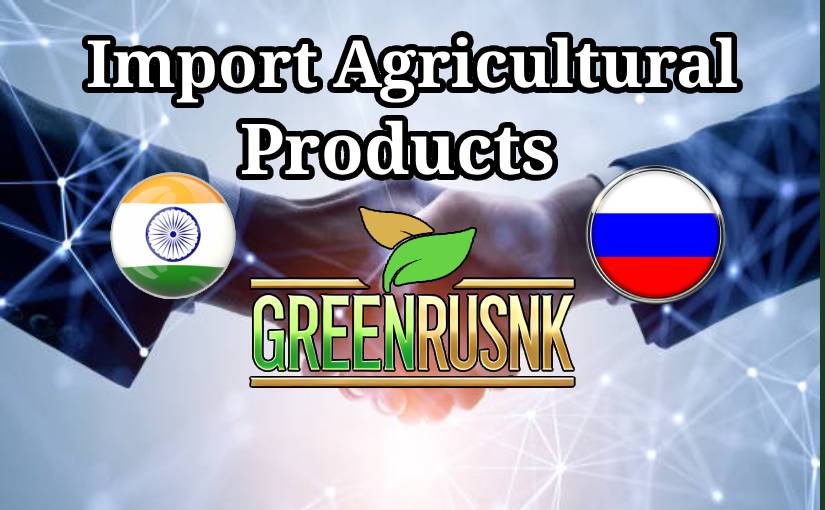import agricultural products from Russia to India
A New Chapter in Russia–India Agricultural Trade
The trade relationship between Russia and India has entered a new phase of strategic growth. Over the past decade, agricultural cooperation between the two nations has strengthened as both sides recognized the immense potential of direct import and export of agri-products. Today, more and more Indian importers are choosing to import agricultural products from Russia to India due to Russia’s reputation for large-scale production, quality assurance, and competitive pricing.
India’s growing population and food industry demand stable and diverse sources of supply. Russia, with its vast farmlands and advanced agritech, offers exactly that — consistent volumes of grains, oilseeds, pulses, and fertilizers ready for export.
1. Why Import Agricultural Products from Russia to India?
There are several reasons behind the rise in agricultural imports from Russia to India. First, the diversification of India’s import sources has become a national priority to ensure food security and stable pricing. Second, Russia has developed strong logistics routes via the Caspian Sea, the International North–South Transport Corridor (INSTC), and direct shipping links to Indian ports.
In addition, Russian agro-products are known for their high quality, natural cultivation methods, and affordability. As a result, Indian buyers can now import large quantities without relying on middlemen or facing excessive tariffs.
2. Major Agricultural Products Imported from Russia to India
The list of agricultural goods imported from Russia to India is growing each year. The following categories dominate the trade market:
- Grains: Wheat, barley, and corn — key staples in India’s food and feed industries.
- Pulses: Lentils, green peas, and chickpeas, which complement India’s massive pulse consumption demand.
- Edible Oils: Sunflower oil and flaxseed oil — popular choices for the Indian consumer market.
- Fertilizers: Potash, urea, and organic fertilizers essential for India’s agricultural production.
- Oilseeds and Feed: Soybean meal, rapeseed, and other high-protein animal feed ingredients.
- Honey and Natural Products: Raw honey, beeswax, and herbal extracts gaining popularity in India’s organic market.
Each of these categories shows steady year-on-year growth as both countries simplify trade routes and customs documentation.
3. Trade Volume and Growth Potential (2025–2030)
The trade volume of agricultural goods between Russia and India has increased by more than 30% since 2020 and is expected to double by 2030. India’s food processing industry, which contributes significantly to its GDP, relies on steady imports to maintain production levels.
Market analysts predict that the value of agricultural imports from Russia to India will exceed $7 billion USD annually by 2030. The demand for lentils, sunflower oil, and fertilizers will drive this growth.
4. Logistics and Transportation Corridors
The logistics network between Russia and India is evolving rapidly. The International North–South Transport Corridor (INSTC) has shortened delivery times from 40 days to about 25 days by connecting Russian ports through the Caspian Sea to Iran and then to India’s western ports like Mumbai.
Other routes through the Black Sea and Persian Gulf are also expanding. These efficient corridors reduce freight costs and allow Indian companies to import agricultural products from Russia to India faster than before.
5. Quality Standards and Certification
To ensure quality and safety, Russian agricultural exports follow strict regulations under GOST et ISO standards. Indian importers must also comply with domestic requirements such as FSSAI certification, phytosanitary documentation, and pesticide residue limits.
Working with verified exporters guarantees authenticity, while pre-shipment inspections and lab analyses ensure that every batch meets Indian import laws. These certifications increase buyer confidence and reduce customs delays.
6. Key Opportunities for Indian Importers
The current geopolitical and economic environment creates strong opportunities for Indian importers seeking to expand their supply chain. Russia offers competitive export pricing, stable trade policies, and growing private-sector partnerships.
- Long-term supply contracts for wheat and sunflower oil.
- Joint ventures in food processing and packaging.
- Import of certified organic products and fertilizers.
- Expansion into secondary products like feed, honey, and agricultural chemicals.
By leveraging these opportunities, Indian companies can enhance food security, reduce dependency on Western suppliers, and benefit from Russia’s vast agricultural potential.
7. Challenges and How to Overcome Them
Despite the promising outlook, importers still face challenges when importing agricultural products from Russia to India. These include fluctuating freight costs, currency conversion, and regulatory differences.
However, the increasing cooperation between Russian and Indian trade ministries is addressing these issues through bilateral agreements, easier customs processing, and digital documentation systems.
Indian buyers can mitigate risks by working directly with verified exporters, maintaining clear contracts, and using international payment safeguards such as LC (Letter of Credit).
8. The Future of Russia–India Agricultural Cooperation
The next decade will see deeper collaboration between Russian producers and Indian importers beside BRICS as well. Both nations are investing in smart logistics, digital trade platforms, and renewable farming solutions to ensure long-term agricultural sustainability.
As India’s consumption continues to rise, Russian agricultural exports will play an increasingly central role in the country’s food strategy. This relationship not only strengthens bilateral ties but also contributes to the global balance of food supply and demand.
A Reliable Partnership for the Future
Choosing to import agricultural products from Russia to India represents a strategic decision for companies looking for quality, scalability, and long-term cooperation. With advanced logistics, transparent regulations, and strong government support, this trade corridor is poised to become one of the most dynamic in global agriculture.
From grains and oils to fertilizers and pulses, Russia’s agricultural exports offer Indian importers a competitive advantage that supports both national food security and international business growth.

